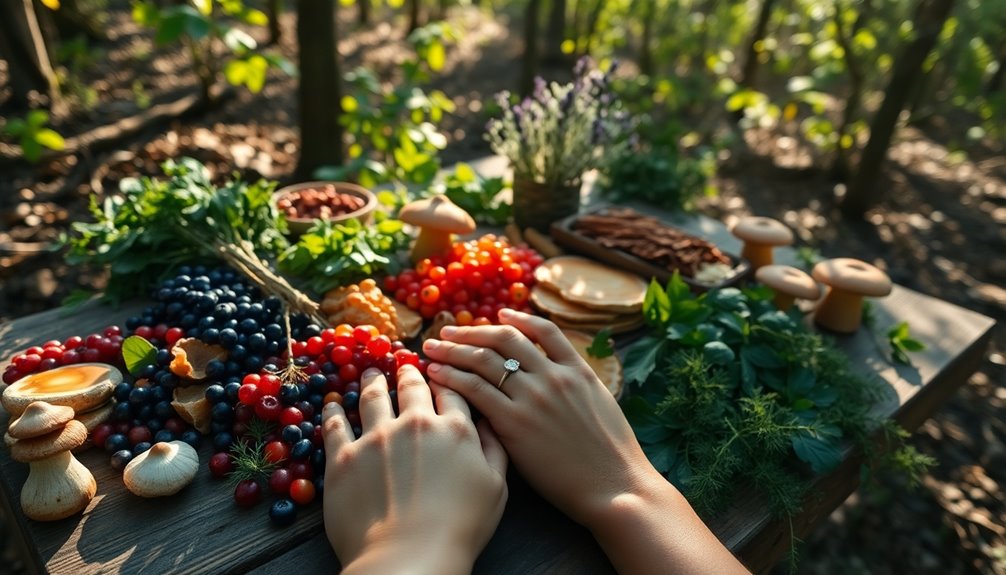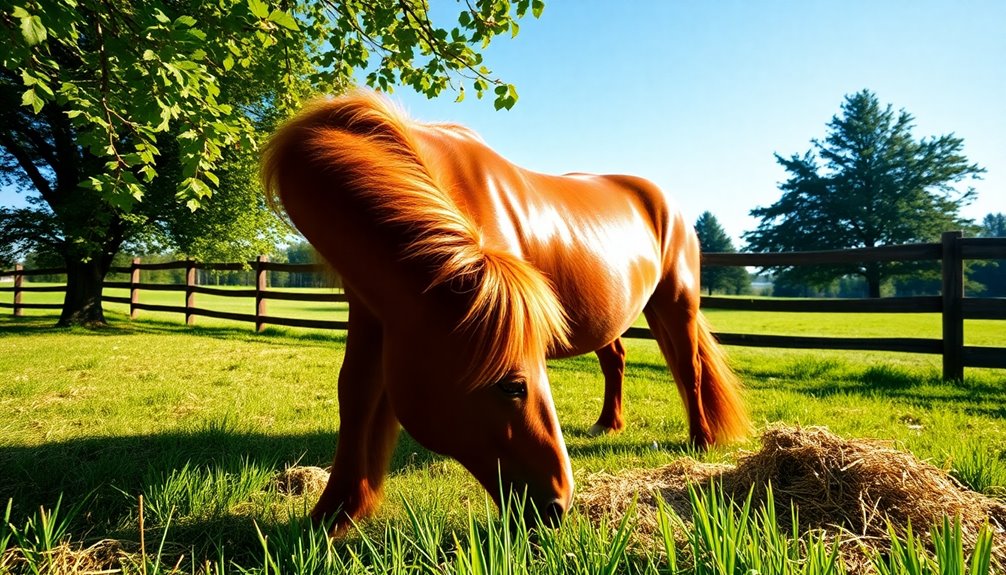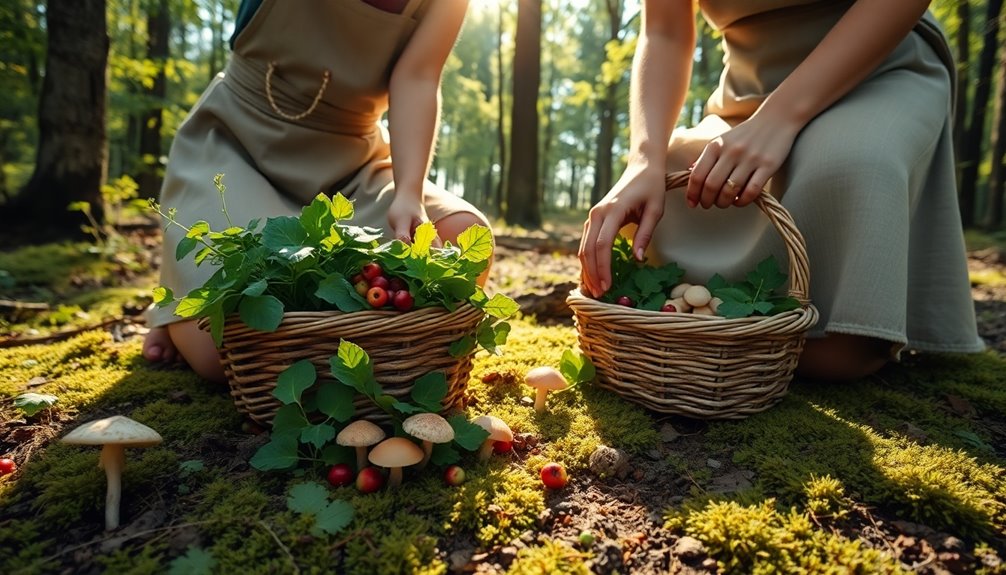In Stardew Valley, the Botanist profession reigns supreme for foragers aiming to maximize profits. At level 10, it guarantees iridium-quality forageables, which sell for higher prices than regular items. While the Gatherer offers a 20% chance to double harvest at level 5, the Botanist's focus on quality ultimately trumps that for long-term income. This choice assures you gather the most valuable forageables, boosting your inventory's worth dramatically. If you want to explore the different strategies and details on how to optimize your foraging game, there's plenty more to uncover.
Key Takeaways
- The Botanist profession guarantees iridium-quality forageables, maximizing inventory value and profitability, making it a top choice for serious players.
- Gatherer enhances early-game profits with a 20% chance to double harvest, ideal for those focusing on quick gold accumulation.
- Forester boosts wood drops by 25%, essential for players dedicated to building and crafting, offering long-term resource benefits.
- Combining Gatherer and Botanist professions maximizes income by increasing both quantity and quality of forageables collected.
- Strategic foraging practices, including seasonal awareness, significantly enhance resource discovery and overall gameplay success.
Overview of Foraging Professions
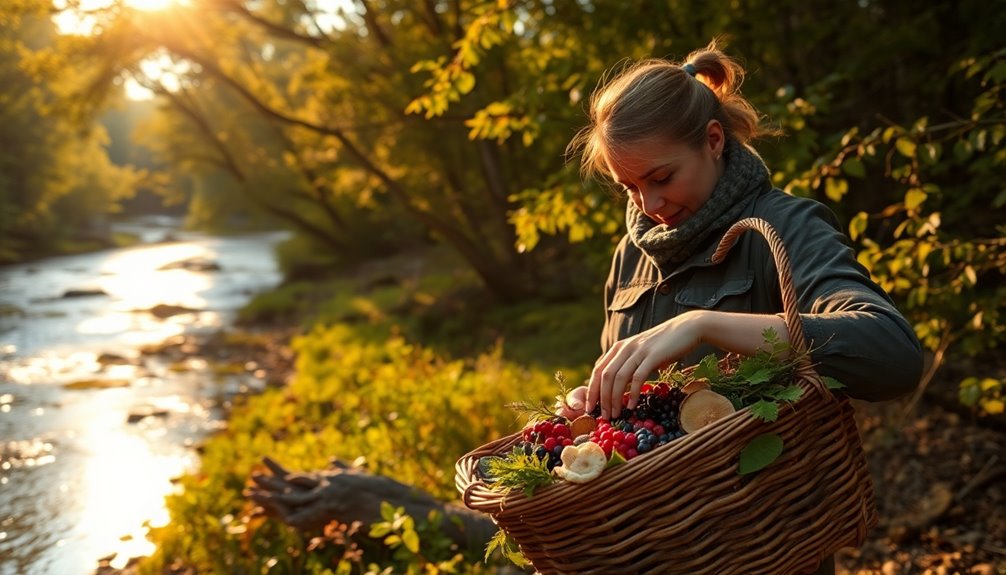
Foraging in Stardew Valley is a dynamic profession that lets you gather various resources from the environment, such as berries, mushrooms, and wood. This skill not only enhances your resource collection but also contributes to your overall progression in the game.
As you level up your foraging abilities, you'll gain access to different foraging professions that cater to your playstyle. At Level 5, you can choose between the Gatherer and the Forester. The Gatherer offers a 20% chance to double harvest forageables, making it a popular choice for those who want to maximize their yields.
The Forester, on the other hand, boosts wood drops by 25%, which is great if you're focused on lumber. As you continue to develop your skills, reaching Level 10 allows the Gatherer to advance to the Botanist. This profession guarantees the highest quality forageables, ensuring you get the best resources possible.
Alternatively, you could choose the Tracker, which helps you locate forageable items more easily. Overall, the Gatherer-Botanist path is often seen as the most advantageous for anyone serious about resource gathering in Stardew Valley.
Level 5 Foraging Choices
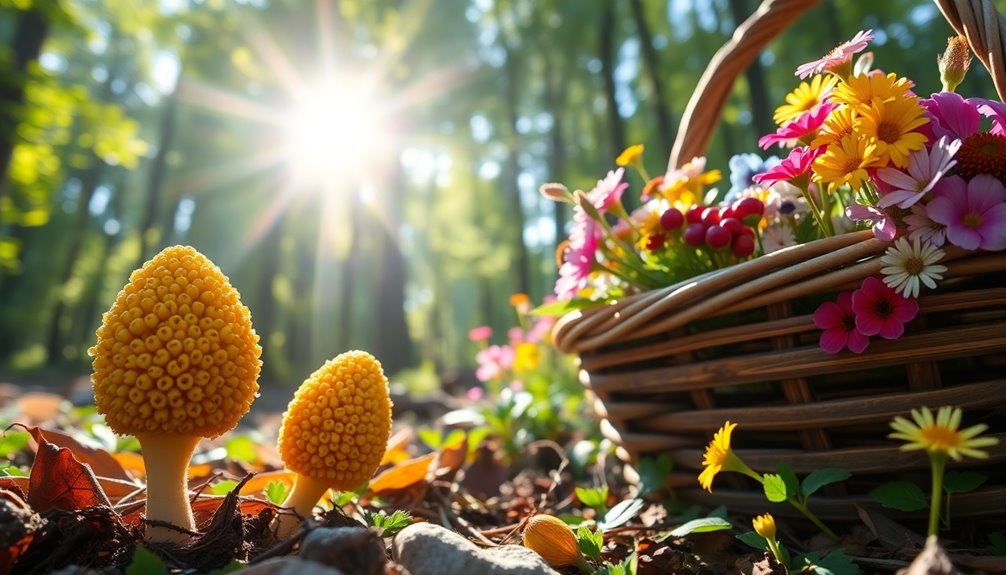
At Level 5 in Foraging, you're faced with a vital decision between the Forester and Gatherer professions.
While Forester boosts your wood collection, Gatherer offers a chance to double your foraged items, making it a popular choice for maximizing early-game income.
Your selection will shape your resource collection strategy and influence your overall gameplay experience.
Level 5 Options Overview
When you reach Level 5 in foraging, you have an important choice to make between two professions: Forester and Gatherer. The Forester profession boosts your wood drops by 25%, making it a solid option if you frequently chop trees for construction or crafting. Additionally, maximizing your wood collection can be particularly useful if you plan to invest in smart home device integration. Moreover, the increased efficiency in wood collection can significantly support your automation's role in crafting processes. In addition to these benefits, a strong foundation in financial planning can help you allocate your resources effectively as you progress in the game. Imagination plays a key role in creative solutions that enhance your gameplay experience.
However, the Gatherer profession offers a 20% chance to double harvest foraged items, which can greatly enhance your resource collection. Many players tend to favor the Gatherer path due to its potential for higher item yields. This versatility in resource generation allows you to accumulate forageables quickly, making it easier to stock up on ingredients for cooking or crafting. Additionally, selecting Gatherer sets you up for a powerful Level 10 option: Botanist, which guarantees the highest quality forageables.
While the Forester's benefits enhance wood collection, they often feel less impactful compared to the doubling effect of Gatherer. If you're looking to maximize your foraging efficiency and profits, choosing the Gatherer profession typically proves to be the best route. Moreover, understanding investment strategies can help you effectively manage the resources you gather for crafting valuable items.
Ultimately, your decision will shape your foraging experience, so weigh the options carefully before committing.
Gatherer vs. Forester
Deciding between the Gatherer Profession and the Forester Profession at Level 5 can shape your gameplay experience dramatically.
If you choose the Gatherer Profession, you gain a 20% chance to double the harvest of foraged items. This boost greatly enhances your resource collection efficiency, allowing you to rake in gold early on through a diverse range of forageables. It's particularly advantageous for crafting, helping you make a name for yourself in Stardew Valley. Regularly foraging can also enhance your mental clarity, as engaging with nature has been shown to reduce stress and improve focus. Additionally, foraging with a focus on developmental benefits can further amplify your engagement with the environment. Moreover, understanding the importance of retirement savings options can help you manage your in-game finances better, ensuring you invest wisely in your farm.
On the other hand, the Forester Profession increases wood drops by 25% from trees, stumps, and logs. While this is beneficial for players focused on wood resources, it may not match the profitability of the Gatherer. Early-game gold income is vital, and the Gatherer's ability to maximize forageable items often proves more lucrative compared to the wood-centric benefits of the Forester.
Ultimately, if you're aiming for quick gold and versatility in resource collection, the Gatherer Profession stands out. Additionally, having a solid understanding of the best hair styling products can enhance your overall gameplay experience by ensuring you look your best while farming.
However, if you're leaning towards woodworking and building, the Forester can be a solid choice. Your decision will greatly influence your approach to survival and expansion in Stardew Valley.
Resource Collection Strategies
Resource collection strategies in Stardew Valley often hinge on your choice between the Gatherer and Forester professions. As a Gatherer, you enjoy a 20% chance to double the harvest of foraged items, which can greatly enhance your early-game profits, especially during Spring. This potential for higher yields makes foraging more lucrative, allowing you to quickly accumulate gold and invest in further upgrades or crops. Additionally, foraged items like turmeric can be used for crafting and cooking, providing further benefits to your gameplay. Historically, foraging practices, much like the use of chia seeds, have been vital to the sustenance of various cultures, showcasing the importance of resource collection in survival. Herbal teas made from foraged herbs can also contribute to your health and wellness in the game.
On the other hand, choosing Forester boosts your wood collection by 25%, which can be advantageous if your focus is on crafting and building. A steady supply of wood is essential for constructing barns, coops, and other structures. However, while Forester provides a reliable resource flow, it doesn't offer the same versatility or profit potential as Gatherer.
Ultimately, if you're aiming for an efficient resource collection strategy, the Gatherer path shines brighter. It allows you to maximize your foraging efficiency and gold income, giving you more freedom to explore other aspects of the game without sacrificing financial growth. Additionally, understanding honey production can further diversify your income streams, particularly if you decide to engage in beekeeping alongside your foraging efforts.
The Power of Gatherer
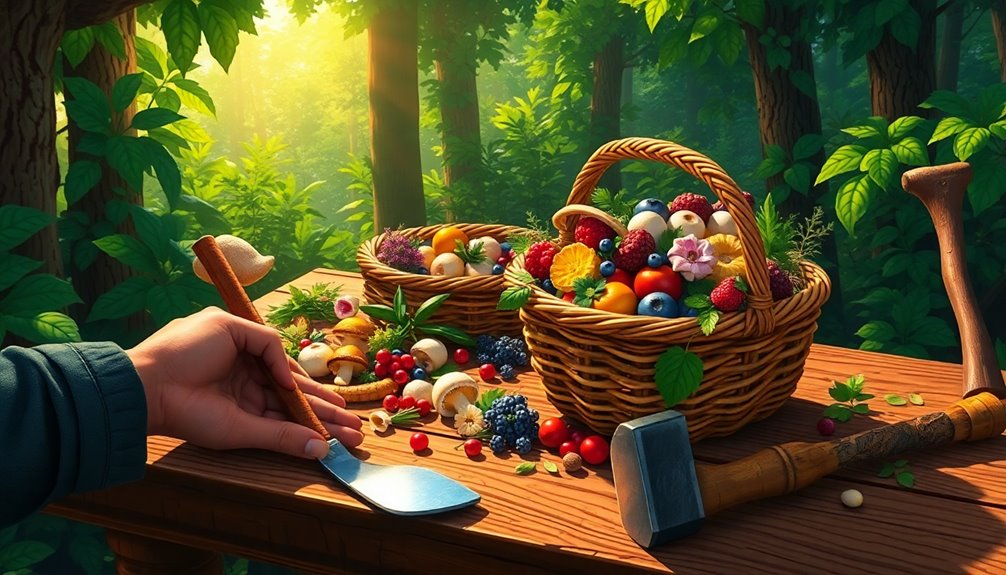
Maximizing your foraging potential in Stardew Valley is a game-changer, especially when you choose the Gatherer profession. With a 20% chance to double your foraged items, the Gatherer path dramatically boosts your resource collection efficiency. Early investment in this profession leads to significant long-term gains, especially during seasons when forageables are plentiful.
Here's a quick comparison of the Gatherer profession's benefits:
| Foraged Item | Base Value (g) | Possible Value with Gatherer |
|---|---|---|
| Wild Horseradish | 50 | 100 |
| Blackberry | 30 | 60 |
| Truffles | 625 | 1,250 |
| Salmonberry | 50 | 100 |
| Spice Berry | 80 | 160 |
As shown, Truffles stand out as a high-value forageable. When you combine the Gatherer with the Botanist specialization, you not only double your Truffle yield but also guarantee the highest quality, maximizing your profits. This makes the Gatherer profession a powerful choice for players looking to optimize their Stardew Valley foraging experience.
Botanist: Quality Over Quantity
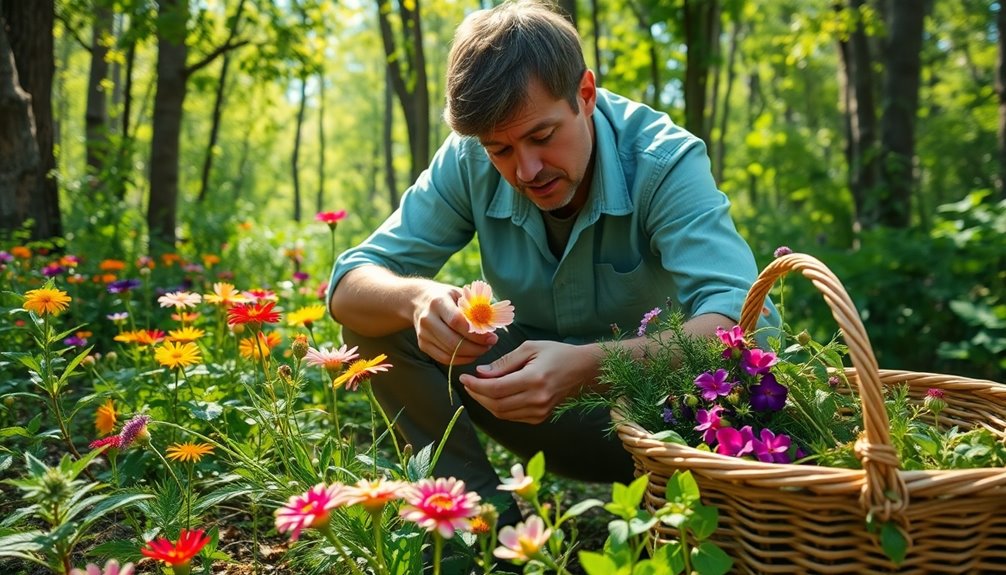
When you choose the Botanist profession in Stardew Valley, you're prioritizing quality over quantity in your foraging efforts. As a botanist, every foraged item you collect will be of the highest quality, ensuring maximum value for your inventory. You won't have to worry about filling your bag with lower-quality forageables, which means you can carry more valuable items for crafting or selling. Regular outings to parks for socialization provide additional opportunities to enhance your overall strategy in the game.
For instance, imagine finding iridium-quality truffles generated by your pigs. Under your botanist profession, these truffles sell for an impressive 625g each, greatly boosting your income. This focus on high-quality forageables allows you to maximize profits while maintaining resource efficiency.
Moreover, combining the Botanist profession with the Gatherer can further enhance your early-game income. With a higher likelihood of obtaining valuable forageables, you'll see your earnings skyrocket.
Ultimately, as a botanist, you're not just foraging; you're making strategic choices that will pay off in the long run. By emphasizing the quality of foraged items, you set yourself up for success in the vibrant world of Stardew Valley. Additionally, this mirrors the concept of emotional alignment which highlights the importance of maintaining positive energy in your choices and actions, further contributing to your overall success.
Comparing Gatherer and Botanist
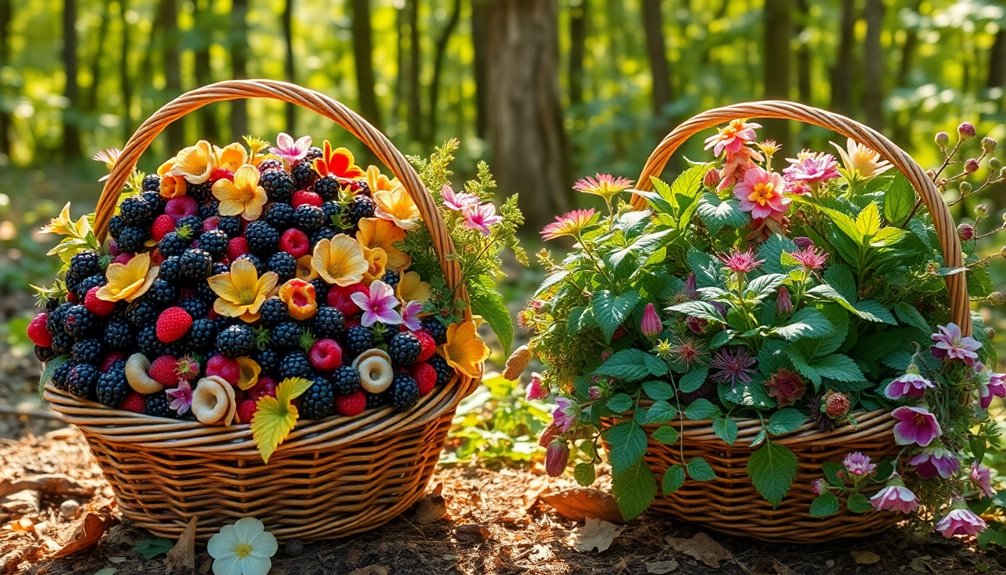
Choosing between the Gatherer and Botanist professions can greatly impact your foraging strategy in Stardew Valley.
As a Gatherer, you get a 20% chance to double the harvest of foraged items at level 5, markedly boosting your resource collection. This means more berries, mushrooms, and other foraged items, which can be invaluable for your farm's profitability.
When you reach level 10, you can opt for the Botanist profession. This choice guarantees that all foraged items will be of the highest quality, including iridium-quality Truffles. By ensuring that your foraged items are excellent, you'll not only save inventory space but also increase your profits when selling them.
Combining the Gatherer and Botanist paths is ideal for players who prioritize both quantity and quality. With the Gatherer's ability to double your harvest and the Botanist's assurance of iridium quality, you'll maximize both your resources and profit margins.
In comparison, the Tapper profession offers only a modest 25% increase in syrup sales. As a result, the Gatherer and Botanist professions stand out as the superior choice for effective resource management and profit in Stardew Valley.
Alternative Foraging Paths
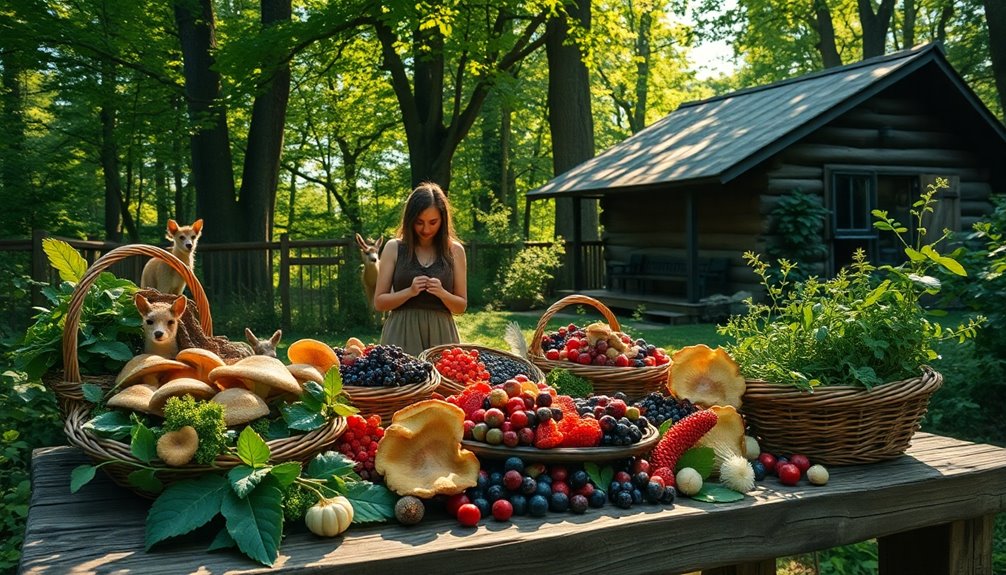
If you're considering alternative foraging paths, the Forester profession might catch your interest, especially for crafting and building. Heat pumps, much like the Forester's ability to enhance resources, can reduce energy consumption significantly, leading to more efficient resource management in your gameplay. Additionally, by utilizing heat pumps, you can experience a significant reduction in carbon emissions, helping to create a more sustainable environment both in-game and in real life. Furthermore, similar to how hydrogen fuel cells generate zero harmful emissions, the Forester's practices contribute to a cleaner ecosystem. Moreover, implementing solar energy solutions in your community can enhance sustainability efforts and complement the Forester's resource management.
While the Botanist guarantees high-quality foraged items, the Forester enhances wood yield considerably. Each choice offers unique benefits, so think about your playstyle and what resources you need most. Additionally, understanding the impact of long-term financial planning can help you make informed decisions about your in-game resources and investments.
Forester vs. Gatherer
Foraging in Stardew Valley presents players with two distinct paths: the Gatherer and the Forester. Each offers unique benefits that cater to different playstyles, so it's vital to weigh your options.
| Profession | Key Benefits |
|---|---|
| Gatherer | 20% chance to double foraged items |
| Forester | 25% increase in wood drops from trees |
| Level 10 Option | Botanist guarantees high-quality forageables or Lumberjack allows any tree to drop Hardwood |
If you choose the Gatherer, you'll enjoy a significant boost in item quantity, making it perfect for early-game resource collection. At level 10, opting for Botanist means you can guarantee top-quality forageables, including valuable Truffles.
On the other hand, the Forester is ideal if wood gathering is your focus. With a 25% increase in wood drops, you'll quickly gather materials for crafting and building. By selecting Lumberjack at level 10, you'll guarantee that all tree types yield Hardwood, a vital resource for advanced projects.
Ultimately, your choice should reflect your priorities—maximize foraged items with Gatherer or enhance your wood collection with Forester.
Botanist's Quality Advantage
Opting for the Botanist profession in Stardew Valley opens up a significant quality advantage that can transform your foraging experience. By choosing this path, you guarantee that all foraged items are of the highest quality, maximizing both your selling prices and inventory efficiency.
Here's how the Botanist stands out:
- Higher-quality foraged items stack better, saving you precious inventory space.
- Foraged Truffles sell for 625g when harvested as high quality, compared to lower-quality versions, which fetch less.
- This quality guarantee is a boon for crafting artisan goods, which can yield substantial profits.
While the Gatherer path offers double harvests, the Botanist's consistent quality often leads to more profitable outcomes.
When you focus on foraged items, you'll find that the Botanist's advantages allow you to craft and sell artisan goods more effectively. This means not only better profits but also a more streamlined inventory that keeps your farm running smoothly.
Importance of Foraging in Gameplay
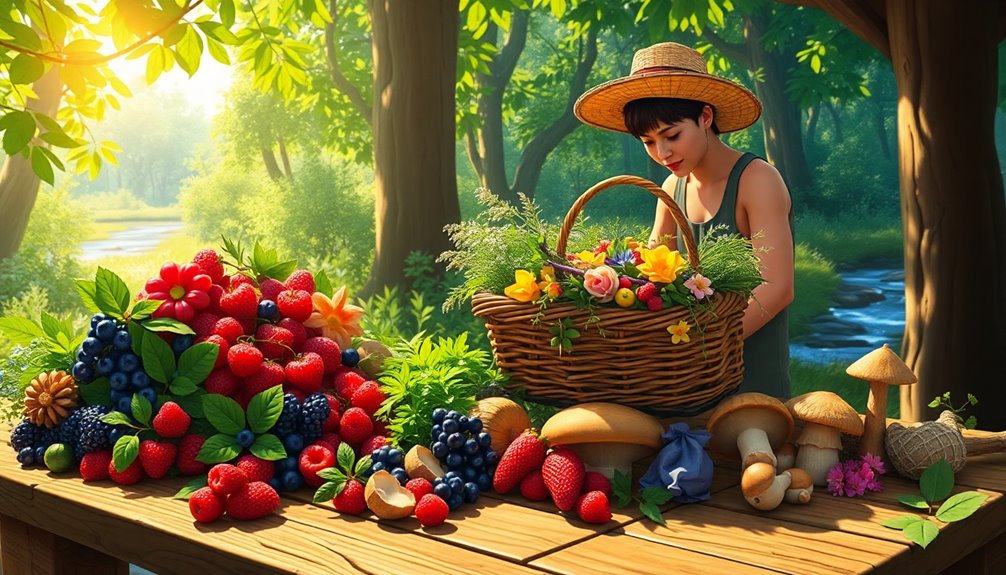
Why should you prioritize foraging in Stardew Valley? Foraging is essential for gathering resources like wild fruits, mushrooms, and crafting materials. These elements enhance your overall income and crafting capabilities, making your farm more productive. By opening up foraging professions, you can greatly boost your efficiency. For instance, the Gatherer gives you a 20% chance for double harvests on foraged items, while the Botanist guarantees all your foraged goods are top quality.
Here's a quick breakdown of the benefits of foraging:
| Foraging Benefit | Description | Impact on Gameplay |
|---|---|---|
| Resource Gathering | Provides food and crafting materials | Vital for survival |
| Professions | Opens up skills like Gatherer and Botanist | Enhances efficiency |
| Seasonal Variety | Different items available each season | Dynamic gameplay |
| Economic Support | Foraged items often sell for higher prices | Boosts overall income |
Foraging not only supports your economy but also keeps the gameplay dynamic and engaging. By embracing foraging, you're setting yourself up for success in Stardew Valley!
Maximizing Profits From Foraging

Maximizing your profits from foraging in Stardew Valley involves leveraging the unique benefits of your chosen professions. By focusing on the right paths, you can substantially increase your income from foraged items.
Here's how to get the most out of your foraging endeavors:
- Choose the Gatherer profession at level 5 for a 20% chance to double your harvested items, boosting your quantity.
- Opt for Botanist at level 10 to guarantee all foraged items are the highest quality, maximizing their selling price and saving inventory space.
- Consider the Lumberjack path at level 10, which allows any tree type to drop Hardwood, a valuable resource for crafting and selling.
Combining the benefits of Gatherer and Botanist can yield a consistent and lucrative income stream, especially during seasons rich in forageables.
For example, unprocessed Truffles can sell for a staggering 625g each, compared to lower-value foraged items.
Community Insights on Foraging
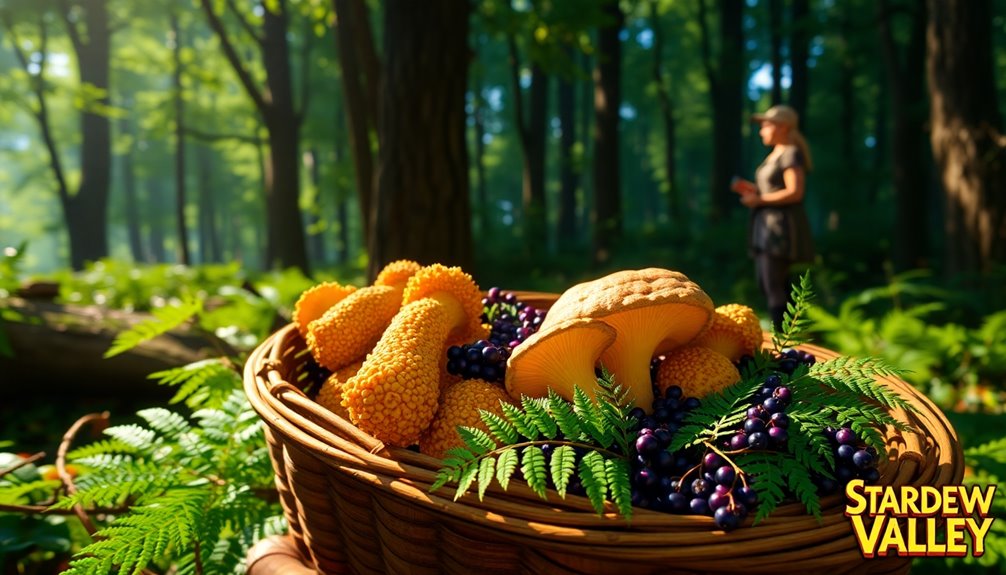
When it comes to foraging, players often share their favorite techniques for gathering high-value items.
You'll find that strategies vary, but many agree that focusing on Truffles and other premium forageables can boost your profits considerably. Additionally, incorporating foraging toys can enhance your gameplay experience by providing a fun way to engage with the environment and discover valuable items.
Let's explore which methods work best and how you can efficiently gather these coveted resources.
Preferred Foraging Techniques
Foraging effectively in Stardew Valley relies on adopting the right techniques to boost your haul. Choosing the Gatherer profession at level 5 can greatly enhance your foraging experience. With a 20% chance to double your harvest of forageables, this path is perfect for maximizing your early-game income.
To elevate your foraging game, consider these techniques:
- Capitalize on Seasonal Changes: Different forageables appear in different seasons. Plan your foraging trips around these changes to diversify your collections.
- Participate in Community Events: Events like the Egg Festival or Luau can introduce unique forageables. Engaging in these events not only enriches your inventory but also increases your profits.
- Transition to Botanist at Level 10: After establishing a solid income from Gatherer, consider switching to Botanist. This guarantees that all foraged items are of the highest quality, maximizing their selling potential.
Highest Value Foraged Items
One of the best ways to boost your income in Stardew Valley is by focusing on the highest value foraged items. Truffles, which sell for an impressive 625g each, are among the most profitable options when harvested from pigs trained on your farm.
If you choose the Botanist profession, you'll guarantee that your foraged items are always of the highest quality, maximizing their sale value and overall profit. Notably, improving emotional well-being can also be a beneficial aspect of engaging in foraging as a calming and enjoyable activity.
Don't overlook the culinary creations you can craft with foraged ingredients, like Fiddlehead Risotto and Salmon Dinner, which also bring in significant profit.
Seasonal foraging adds another layer of excitement, allowing you to find unique items like Wild Horseradish in Spring and Blackberry in Fall, enhancing your income through seasonal sales.
Additionally, tapping trees for Maple Syrup and Poppy Honey can yield profits of up to 250g and 200g, respectively.
By strategically focusing on these highest value foraged items, you can create a sustainable income stream while enjoying the diverse foraging experience Stardew Valley offers. Furthermore, employing energy-saving features can help maximize your efficiency in managing your farm's resources, leading to even greater profits.
Strategies for Efficient Gathering
Maximizing your foraging efficiency in Stardew Valley requires a strategic approach that combines skill selection and seasonal awareness.
By choosing the right paths, you can enhance your foraged items and boost your early-game gold income considerably.
To optimize your gathering strategies, consider the following:
- Select the Gatherer profession at level 5: This gives you a 20% chance to double your foraged items, a game-changer for early-game profits.
- Aim for Botanist at level 10: This guarantees the best quality forageables, including lucrative Truffles, maximizing your selling prices and minimizing inventory issues.
- Adapt to seasonal changes: Each season brings unique foraged items.
Explore different areas periodically to discover rare finds and maximize your gathering opportunities.
Final Thoughts on Foraging Professions
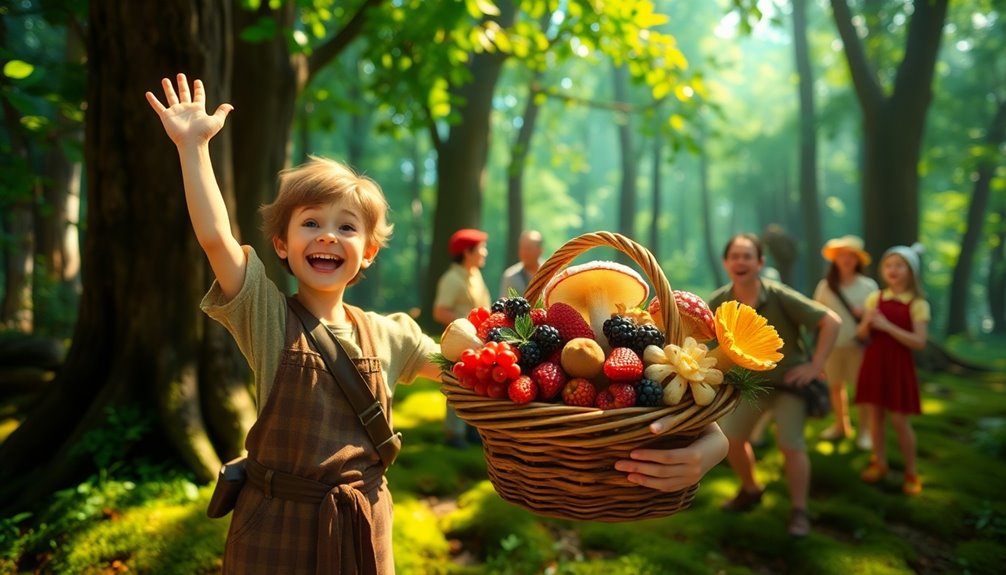
When considering the best paths for foraging professions in Stardew Valley, the Gatherer and Botanist routes emerge as top contenders.
Choosing the Gatherer profession at level 5 gives you a 20% chance to double your harvest of foraged items. This can greatly boost your early-game income, making it an attractive option for any player focused on foraging.
At level 10, selecting the Botanist guarantees that all your forageables are of the highest quality. This maximizes their selling price and saves you valuable inventory space.
The combination of Gatherer and Botanist not only enhances your basic foraging capabilities but also increases Truffle production from pigs, leading to lucrative sales at 625g each.
In contrast, while the Forester path improves wood collection efficiency, it's generally less profitable for those prioritizing foraging.
If you want to maximize profit and resource collection, the Gatherer-Botanist route clearly stands out. Embracing these paths allows you to reap the most benefits from foraging, ensuring your Stardew Valley farm thrives.
Ultimately, you can't go wrong with this powerful duo!
Frequently Asked Questions
What Is the Best Profession for Foraging in Stardew Valley?
When you're considering the best profession for foraging in Stardew Valley, you'll want to focus on maximizing both quantity and quality.
The Gatherer profession at level 5 gives you a solid 20% chance to double foraged items, while the Botanist at level 10 guarantees all your foraged goods are top quality.
Combining both allows you to collect more valuable items efficiently, making them the ideal choices for any aspiring forager.
Is It Better to Choose Forester or Gatherer?
Imagine you're selling Truffles for 625g each while your friend focuses on collecting wood.
When considering whether to choose Forester or Gatherer, you'll likely find Gatherer more rewarding. With a chance to double your forage harvest and the option to pick Botanist for high-quality items, your profits soar.
While Forester offers extra wood, it doesn't compare to the income potential you gain by maximizing foraged goods, especially if you're after Truffles.
Which Level 10 Foraging Profession Is Better?
When you reach Level 10 in foraging, you've got a tough choice to make between the Botanist and Tracker professions.
If you're aiming for maximum profit, the Botanist is your best bet. You'll guarantee high-quality forageables, which means more money and less inventory clutter.
The Tracker's directional help pales in comparison, especially since it doesn't boost the value or quantity of what you gather.
Choose Botanist for the best rewards!
Which Level 5 Foraging Profession Is Better?
When you consider the benefits of each Level 5 foraging profession, you weigh immediate gains against long-term goals.
If you choose the Gatherer, you'll enjoy a 20% chance to double your foraged items, boosting your early-game income.
If you opt for Forester, you'll get a 25% increase in wood drops, useful for crafting.
Ultimately, if profit is your priority, Gatherer's the clear choice, setting you up for more lucrative paths later.
Conclusion
In the domain of foraging, you've got the power to choose your path. Whether you lean towards the Gatherer's generous gains or the Botanist's beautiful bounty, each profession offers unique perks. Embrace your foraging future with flair, and remember: your choices can change your Stardew story. So, gather your goodies and bloom your botanicals, because in the vibrant land of Stardew Valley, every forager finds their fortune in flavor and fun!

